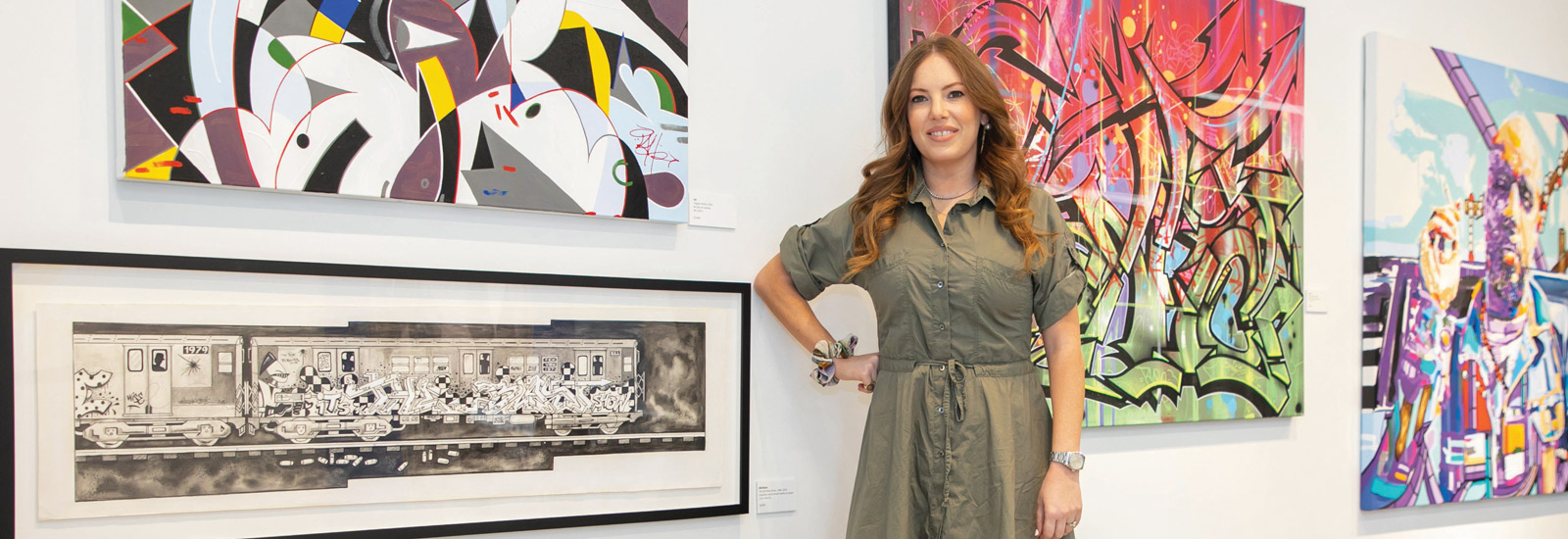by ALAN GOMEZ
PHOTO BY Jenny Abreu
Allison Freidin’s corner of the State Attorney’s Office in Miami was hard to miss.
While other prosecutors hung their law school diplomas and vacation pictures in their offices, graffiti and other urban art plastered Freidin’s walls, desk, and door. Raw, colorful pieces by Miami-based urban artists Neith Nevelson, Atomik, and Ahol Sniffs Glue screamed out amid the bland, antiseptic halls.
“People would come to visit my office because they wanted to see the art,” said Freidin, B.S. ’07, J.D. ’10. “They would say, ‘Oh my god, it’s like a gallery in here.’ And I would say, ‘Just wait.’”
Sure enough, Freidin left her job prosecuting criminals and teamed up with a graffiti historian to open the Museum of Graffiti, a first-of-its-kind tribute to urban culture and street art. The museum is now a cornerstone of Wynwood, not only surviving the COVID-19 pandemic but expanding to accommodate more shows, exhibits, and guests.
While the jump from a Miami Law-trained prosecutor to graffiti art museum co-founder may seem jarring, it was, in retrospect, a natural transition for Freidin based on two factors.
The first was her lifelong love of the art form. The third-generation Miamian, who grew up in Coconut Grove, was fascinated by street art form from an early age. She would spend time with artists, learning the message behind their work and realizing there was a void in the art world for street artists to have their voices heard.
The second revelation came six years into her career as a prosecutor. Freidin was assigned to the Northside District of the Miami-Dade Police Department’s office near Liberty City as a founding member of the department’s Anti-Gun Violence Task Force. There, she helped institute a data-driven approach to shootings, pioneering the now-common practice of police departments using historical shooting trends to anticipate where the next wave of shootings would be.
But then, in quick succession, two police officers she had been working closely with were shot in the line of duty.
“Neither of them died, but as the danger levels rose and as I looked into the future for myself in terms of personal growth, those two factors came together,” she said. “Art was always 100% my passion. I just wasn’t really sure how to make that transition and how I was going to be able to make a living and continue to benefit my community.”
The Birth of a Museum
Remaining in an urban environment was essential to Freidin. She started by representing graffiti artists. And then, she met Alan Ket, a New York-based graffiti artist, historian, and documentarian who was in town to work at Wynwood Walls during Art Basel in 2017.
The two bonded over their shared disappointment over what was happening to Wynwood. The neighborhood had grown rapidly and become an international destination but didn’t have any place where visitors could learn about the art they saw and its history.
“Ket is a graffiti artist, so he gets to see this all from a very insider’s perspective. I came with a goal of service to the community and urban art education,” Freidin said. “We fit together like peas and carrots.”
They developed their concept, but the hard part came with building a museum from scratch. Neither had experience doing so, and nobody had ever built a museum specifically about graffiti before, so the two had to make things up as they went.
That’s when Freidin fell back on the lessons she learned at Miami Law.
She credited Professor Ben Depoorter, her intellectual property professor, for using pop culture and current-day IP cases to show his students the real-life application of complex federal copyright laws. The museum launched with officially licensed, limited-edition merchandise, loan agreements for six-figure artwork, and consignment contracts for artists selling their works.
I use the knowledge I learned in IP every single day when I do my job, whether it’s getting Visual Artists Rights Act of 1990 waivers for murals or looking at licensing deals with our corporate sponsors.
They’ve even helped her navigate the emerging world of NFTs.
“The standard principles of IP apply even in the metaverse,” she said. She recently co-founded Glyphic NFTs, a company to help street artists leverage generative WEB3 technology to create non-fungible tokens.
Enduring the Pandemic
Holding onto the museum throughout the pandemic took a different kind of work. Freidin and Ket had to shut down like everybody else during the 2020 quarantine, so they got creative.
They created digital galleries for artists. They broadcasted art talks, made downloadable coloring books for children, and opened an online gift shop. When businesses slowly started reopening, they helped visitors customize their masks with spray paint.
“The DIY spirit of this museum is very consistent with aspects of the art form itself,” she said.
Freidin still worries about the future of Wynwood, about developers bowling over the very art that gave birth to the neighborhood. “There is no art preservation in Miami’s arts district,” she said.
She hopes the museum and her broader work elevating local artists and female entrepreneurs can help save the art she’s been admiring all her life. “The common thread of everything that I’ve done is to be of service to my community,” she said.




